Our tool for managing your permission to our use of cookies is temporarily offline. Therefore some functionality is missing.
THE LATEST BMW Z4 SERIES.
BMW Z MODELS OVERVIEW.
At the end of the 80s, BMW refocused on the roadster tradition that stemmed from models such as the legendary BMW 507: two-seater, open-top vehicles which were all about driving pleasure. So “Z” could stand for the German word for future, “Zukunft.” And it is true that all Z series models are characterized by exceptionally innovative, visionary vehicle specifications.
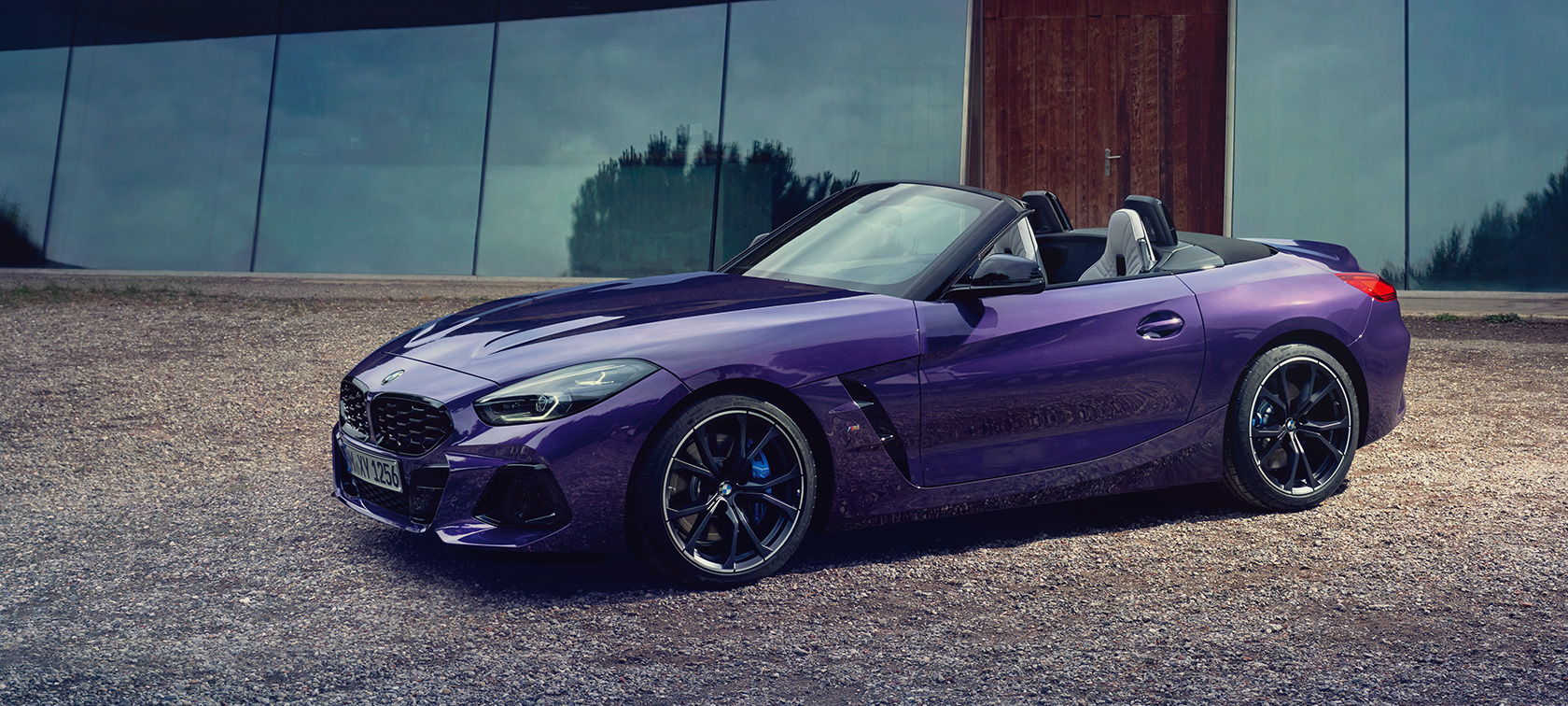
A BRIEF HISTORY OF THE BMW Z SERIES.
Discover the development, history and evolution of the extraordinary, ahead-of-its-time BMW Z Series Roadster. Find out how classics such as the BMW Z1 and BMW Z8 are created, as well as vehicles for a wider audience – the BMW Z3 and BMW Z4.
A BRIEF HISTORY OF THE BMW Z SERIES.
Discover the development, history and evolution of the extraordinary, ahead-of-its-time BMW Z Series Roadster. Find out how classics such as the BMW Z1 and BMW Z8 are created, as well as vehicles for a wider audience – the BMW Z3 and BMW Z4.
THE BMW Z1.
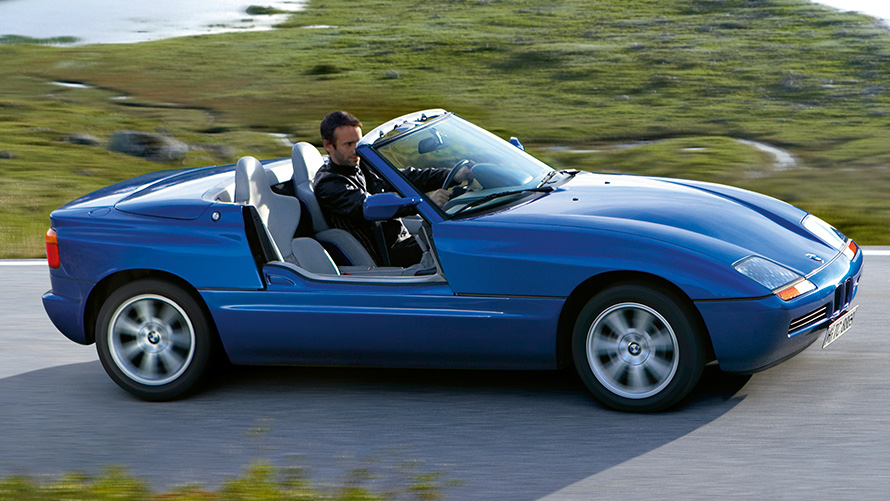
(E30/Z)
Following in the footsteps of legendary roadsters such as the BMW 328 and BMW 507, BMW launches a two-seater at the end of the 80s that will in turn become a classic: The BMW Z1. Designed as a concept car by BMW Technik GmbH, the trial is such a success that the vehicle is developed for the road.
Under the leadership of the then Chief Designer Harm Lagaay, the BMW Z1 is a roadster of groundbreaking design. The extremely flat radiator grille and the falling hood hint at this vehicle’s extreme cornering dynamics and precise driving behavior.
Technically, the car is based on the BMW 3 series (E30), but that’s where the similarity to a production vehicle ends. That’s due, among other things, to the extraordinary design and the fact that all 8,000 units of the strictly limited roadster are manufactured by hand. The BMW Z1 is the only vehicle whose prototypes were both developed and built by BMW Technik GmbH. The car also features several technical innovations. The most striking are the doors that lower into the side skirts, inspiring a pure sense of driving that only a BMW Z1 can convey.
This door design is only possible because of the unique stability and torsional rigidity of the steel monocoque, which is galvanized as a single piece. The chassis not only benefits from special corrosion protection, but is also strengthened by 25 percent. The body consists of fiberglass and plastic parts.
Due to its direct connection to the road, the BMW Z1 delivers a go kart like driving experience. It is powered by a 2.5 liter 6-cylinder engine with 125 kW (170 hp), taken from the then BMW 325i. The lightweight roadster is almost perfectly balanced, particularly as the engine is positioned behind the front axle. BMW successfully adds another classic to the roadster collection.
Production period: 1989–1991
Engine: 2.5 liters (125 kW, 170 hp), 6-cylinder
Length/width/height: 3,921 mm/1,690 mm/1,277 mm
THE BMW Z3.
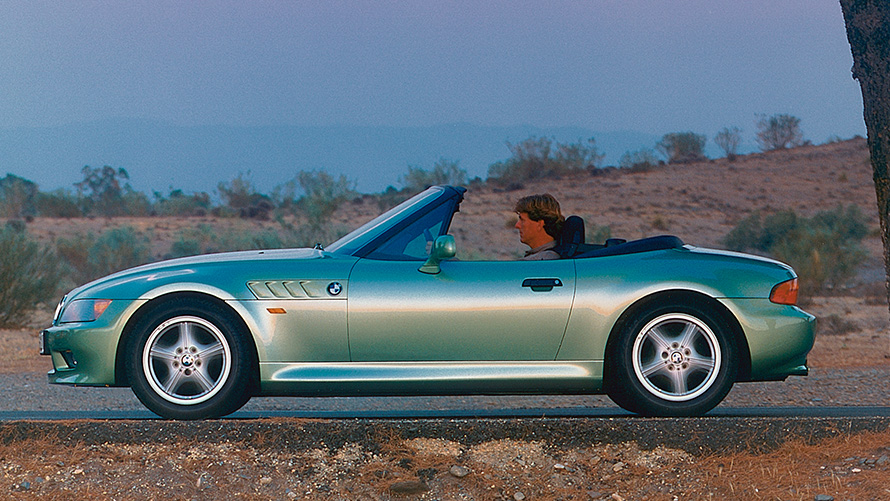
(E36/7)
Inspired by the overwhelming success of the BMW Z1, the Munich-based car manufacturer launches the BMW Z3, a roadster aimed at a wider range of customers. The combination of lightweight construction, two-seater open-top design, and BMW's typical dynamic handling proves unbeatable and survives to this day in its successor, the BMW Z4.
Apart from a few thousand units of the limited edition BMW Z1, there has been no small, open-top two-seater with all the hallmarks of BMW from the company for decades. Then in 1995, the BMW Z3 bursts onto the stage and the streets of the world; small but well powered with precise steering and road holding. This successful concept sells around 297,000 units over seven years.
Initially equipped with a 1.8 liter or 1.9 liter 4-cylinder engine, from 1996 the BMW Z3 is also available with a 6-cylinder engine, delivering 142 kW (193 hp) with a 2.8 liter displacement. The following year welcomes the BMW M Roadster with a 3.2 liter 6-cylinder engine, as used in the BMW M3 (E36), which produces an output of 236 kW (321 hp).
In 1998, BMW pursues a new path and presents the BMW Z3 as a shooting brake, a coupé-like shape. The extravagant shape gives the vehicle an extraordinary look. It is only available with a 6-cylinder engine.
The 1999 model update sees chrome rings added to the roadster’s headlights and a redesigned, more dynamic tail, which is slightly raised at the rear of the fenders. L-shaped taillights make it appear wider. New engines provide even more thrust, such as a 2.2 liter 4-cylinder engine with 125 kW (170 hp). The 2.8 liter 6-cylinder engine is replaced by a 3.0 liter, 170 kW (231 hp) engine. And from 2001, the BMW M Roadster features the engine from the then recently launched BMW M3 (E46): It produces 239 kW (325 hp) and turns the lightweight two-seater into a vehicle with unparalleled dynamics and acceleration.
Production period: 1995–2002
Engines: 1.8–3.2 liters (85–239 kW, 115–325 hp), 4- & 6-cylinder
Length/width/height: 4,025–4,050 mm/1,692–1,740 mm/1,266–1,306 mm
THE BMW Z4.
The direct successor of the BMW Z3 is the BMW Z4. The roadster has now grown significantly and has also improved in terms of comfort – without compromising on dynamics and driving pleasure.
THE FIRST GENERATION OF THE BMW Z4.
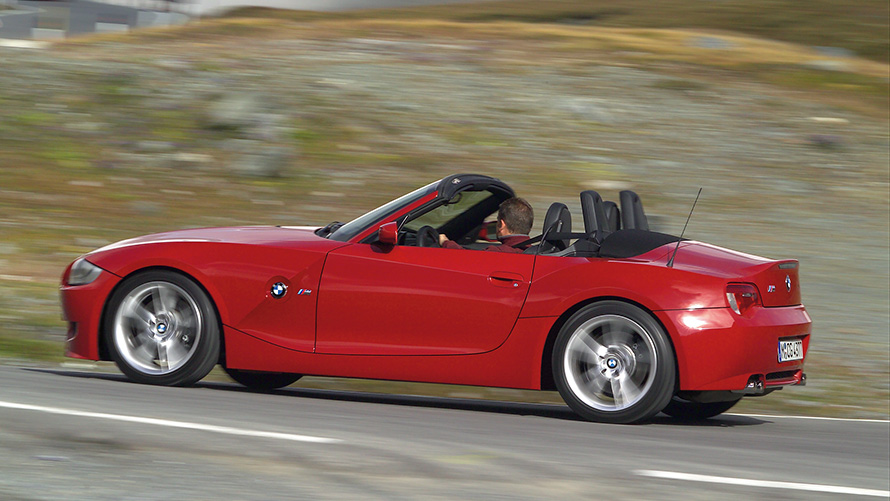
(E85, E86)
The successor to the BMW Z3, created under the auspices of chief designer Chris Bangle, continues the concept of short overhangs, relatively long wheelbase, long hood, short tail. The result is a sporty vehicle, an expressive-dynamic roadster with one objective: creating Driving pleasure with direct contact to the road and a connection to the driving environment, with no sacrifice of comfort and state-of-the-art features. That’s why there’s a choice of high-quality materials for the interior. The soft top has a heated glass rear window, making it durable and suitable for everyday use.
Initially, the BMW Z4 is only available with an inline 6-cylinder engine. It produces 125 kW (170 hp) with a 2.2 liter displacement, 141 kW (192 hp) with 2.5 liters and 170 kW (231 hp) with a displacement of 3.0 liters. A chassis featuring MacPherson strut suspension at the front combined with a multi-link rear axle deliver a driving performance that catapults the roadster to the top of its class in terms of dynamics and agility. From 2005, a new entry-level model is available with a 4-cylinder engine which provides 110 kW (150 hp) with a 2 liter displacement.
In the 2006 model update, the car is given reworked bumpers which, together with the new LED taillights, create an even more dynamic look. The much more dramatic innovation, however, is in the sports car’s power: The new 6-cylinder engine, the N52, delivers more efficiency and performance. Even the smallest engine, for example, generates 130 kW (177 hp) with a 2.5 liter displacement. What’s more, the M variant is now available. The engine comes from the BMW M3 (E46), which generates an output of 252 kW (343 hp) with a displacement of 3.2 liters. This powerhouse also drives the newly introduced coupé. In contrast to the BMW Z3, the vehicle is a hatchback and is also available with a 3.0 liter engine and 195 kW (265 hp).
Production period: 2002–2008
Engines: 2.0–3.2 liters (110–252 kW, 150–343 hp), 4- & 6-cylinder
Length/width/height: 4,091–4,113 mm/1,781 mm/1,268–1,302 mm
THE SECOND GENERATION OF THE BMW Z4.
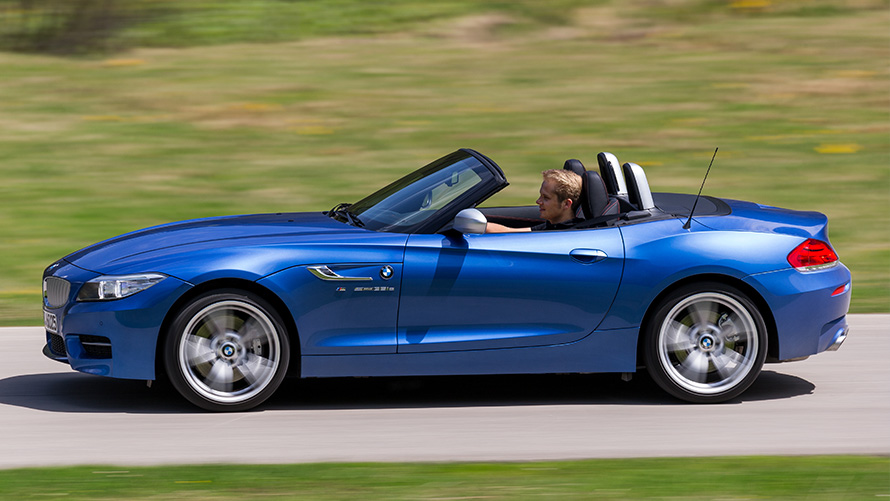
(E89)
Curved lines, long hood, wide tail: The next generation of the BMW Z4 also knows how to inspire. Not least because this vehicle is actively involved in motor sport and a racing version of the car is available to customers.
The evolution of the BMW Z4 (E89) scraps the soft top with an optional hard top and instead gives the roadster a retractable aluminum roof. When closed, there is hardly any difference to a vehicle with a regular roof. This option replaces the coupé.
The first vehicles of this generation are powered by 6-cylinder engines, ranging from the sDrive23i with a displacement of 2.5 liters and 150 kW (204 hp), to the top-of-the-range sDrive35i with a 3.0-liter engine that delivers 225 kW (306 hp). Available from 2010, the sDrive35is also uses this engine. After a reworking, it delivers 250 kW (340 hp) and is the most powerful engine available up to the end of production in 2016. Two turbocharged 4-cylinder engines are available as a model update in 2011. They replace the smaller 6-cylinder engines. 2013 sees a slightly less powerful, entry-level engine: A 2.0 liter 4-cylinder engine with 115 kW (156 hp).
The safety equipment supplied far exceeds the norms of the time. For example, the vehicle is equipped with a brake assist system and an optical display. Flashing the brake lights and automatically activated hazard warning lights show other road users that the BMW Z4 is braking hard.
Such features are standard today but are groundbreaking in 2009. The BMW Z4 also features Driving Dynamic Control that allows the vehicle’s driving characteristics to be adjusted. These include acceleration, the responsiveness of the power steering and gear changes for models with automatic transmission.
Around 115,000 units of the second generation of the BMW Z4 were produced.
Production period: 2009–2016
Engines: 2.0–3.0 liters (115–250 kW, 156–340 hp), 4- & 6-cylinder
Length/width/height: 4,239 mm/1,790 mm/1,291 mm
THE THIRD GENERATION OF THE BMW Z4.
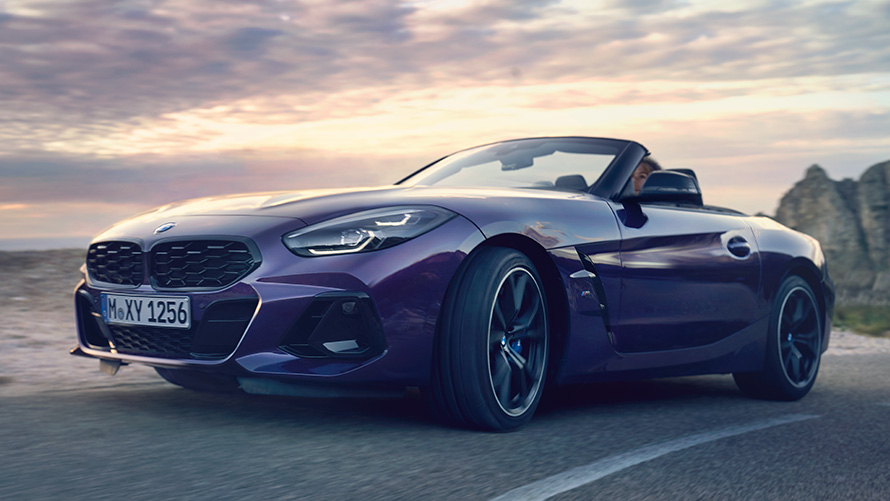
(G29)
The BMW Z4 (G29), the third generation of the roadster, takes the Z idea to its extreme: An unadapted, radically progressive design with M sport package as standard and cutting-edge technology.
In the dark, the LED headlights immediately stand out, and the tail is illuminated by OLEDs, organic light-emitting diodes. The BMW Z4’s sporty presence is noticeable in all light conditions. From the first glance, the vehicle’s progressive handling is highlighted by the dynamic lines from the front, along the long hood, through the lateral profiles to the short, wide tail. Air Breathers, used on the sides behind the front wheel arches, also ensure that only a small amount of air turbulence is formed in the wheel arches. The roadster's fabric roof opens and closes in a breathtaking ten seconds – at speeds of up to 50 km/h.
Thanks to its low road position, excellent weight distribution and tight chassis, the BMW Z4 feels right at home on winding country roads. The high cornering stability ensures extremely precise steering and a lot of driving pleasure. And 4-cylinder Twin Scroll Turbo engines deliver the power that is right for the vehicle.
In the interior, BMW Individual's exclusive materials can be combined in a variety of color combinations to create a highly distinctive look. A Head-Up Display is also available. The BMW Intelligent Personal Assistant is also available and can perform many functions of the BMW Z4 via voice commands.
Production period: 2018–today
Engines: 2.0 litres (190 kW, 258 hp), 4-cylinder
Length/width/height: 4,324 mm/1,864 mm/1,303–1,304 mm
THE BMW Z8.
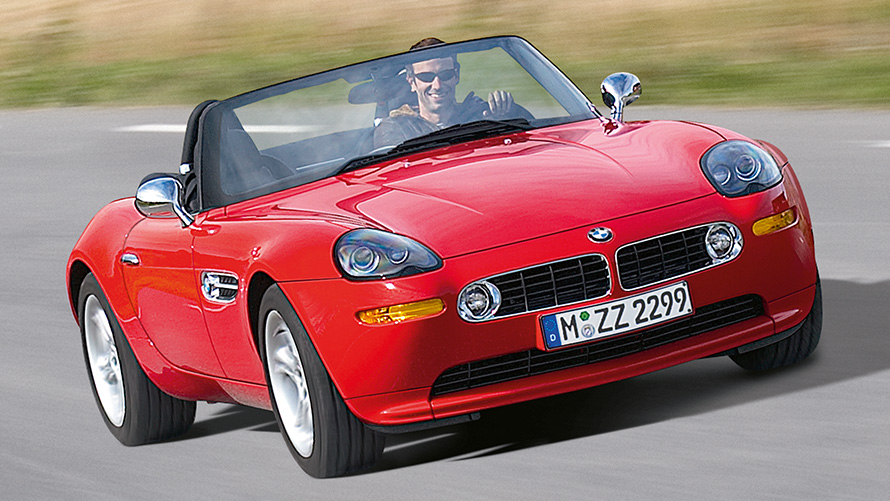
(E52)
Although all the Z models follow the tradition of legendary roadsters such as the BMW 507, when it comes to the design features, the BMW Z8 is more a direct successor to the luxury cars of the 1950s. The exclusive two-seater has similarly curved fenders with a very long hood and short tail. The same applies to the exceptional performance of this elegant and expressive car.
In 1997, the BMW Z07 concept car is exhibited at the Tokyo Motor Show and already features the essential elements of the BMW Z8. The BMW Z8 is created under designer Henrik Fisker and first arrives in showrooms in 2000. With its curved fenders and wide, flat kidney, the car echoes styling elements of the BMW 507, but brings them into the new millennium.
The BMW Z8 boasts an advanced technical design which features a self-supporting aluminum frame (a so-called spaceframe), to which the body parts are attached. This significantly reduces the vehicle’s weight and dramatically improves driving dynamics. The centerpiece is the 5.0 liter 8-cylinder engine from the BMW M5 (E39S) which delivers 294 kW (400 hp) and provides constant acceleration to the top-of-the-range vehicle. At the time it is the most powerful engine from BMW.
The BMW Z8 is supplied with all equipment as standard. This includes a hands-free telephone, navigation system, air conditioning, full leather interior and a fiberglass hard top with heated rear window. And there is a start button on the dashboard – a completely extraordinary detail 20 years ago. From 2000 to 2003, exactly 5,703 units of the luxurious, beautiful and powerful roadster were manufactured. Each one by hand.
Production period: 2000–2003
Engine: 5.0 liters (294 kW, 400 hp), 8-cylinder
Length/width/height: 4,400 mm/1,830 mm/1,310 mm
Fuel consumption and CO2 emissions.
BMW Z4 Roadster:
Fuel consumption in l/100 km (combined): 6.5
CO2 emissions in g/km (combined): 149
The values of fuel consumptions, CO2 emissions and energy consumptions shown were determined according to the European Regulation (EC) 715/2007 in the version applicable at the time of type approval. The figures refer to a vehicle with basic configuration in Germany and the range shown considers optional equipment and the different size of wheels and tires available on the selected model.
The CO2 efficiency specifications are determined according to Directive 1999/94/EC and the European Regulation in its current version applicable. The values shown are based on the fuel consumption, CO2 values and energy consumptions according to the NEDC cycle for the classification.
For further information about the official fuel consumption and the specific CO2 emission of new passenger cars can be taken out of the „handbook of fuel consumption, the CO2 emission and power consumption of new passenger cars“, which is available at all selling points and at https://www.dat.de/angebote/verlagsprodukte/leitfaden-kraftstoffverbrauch.html.



